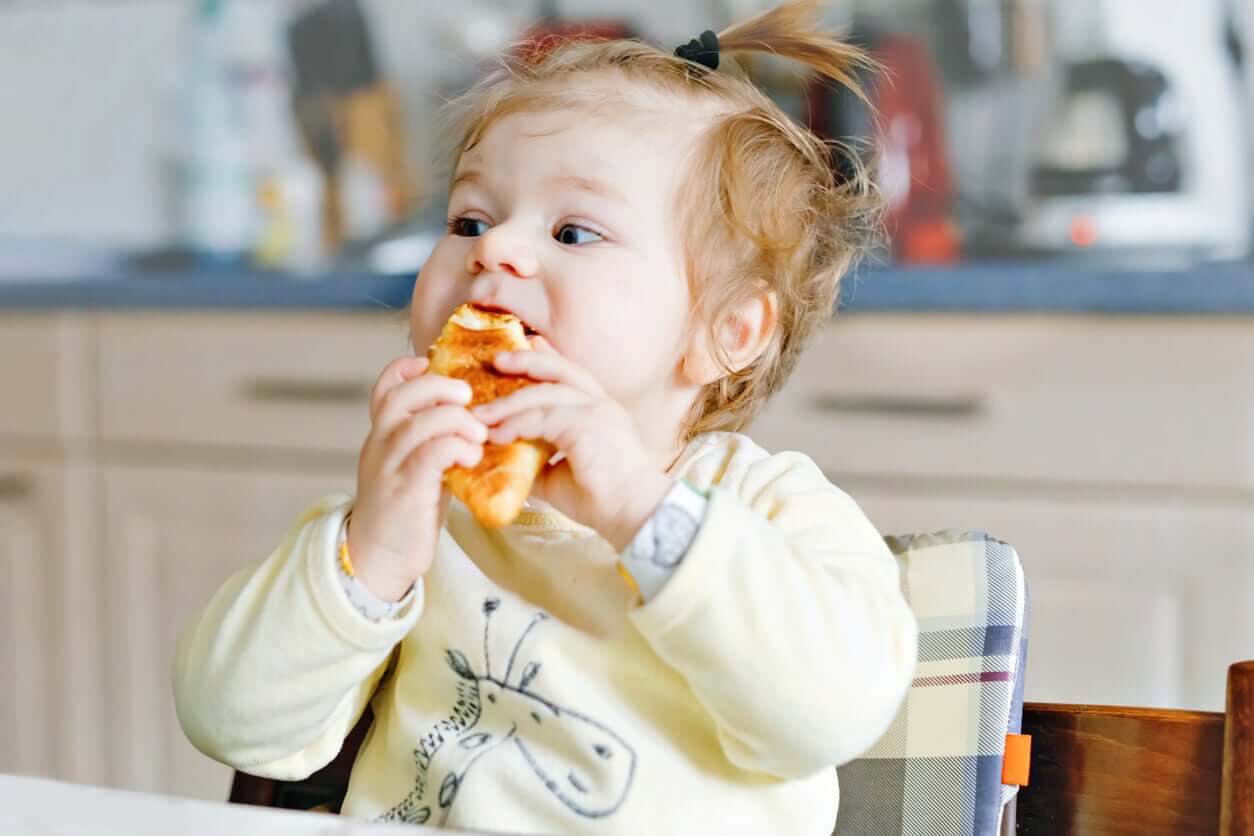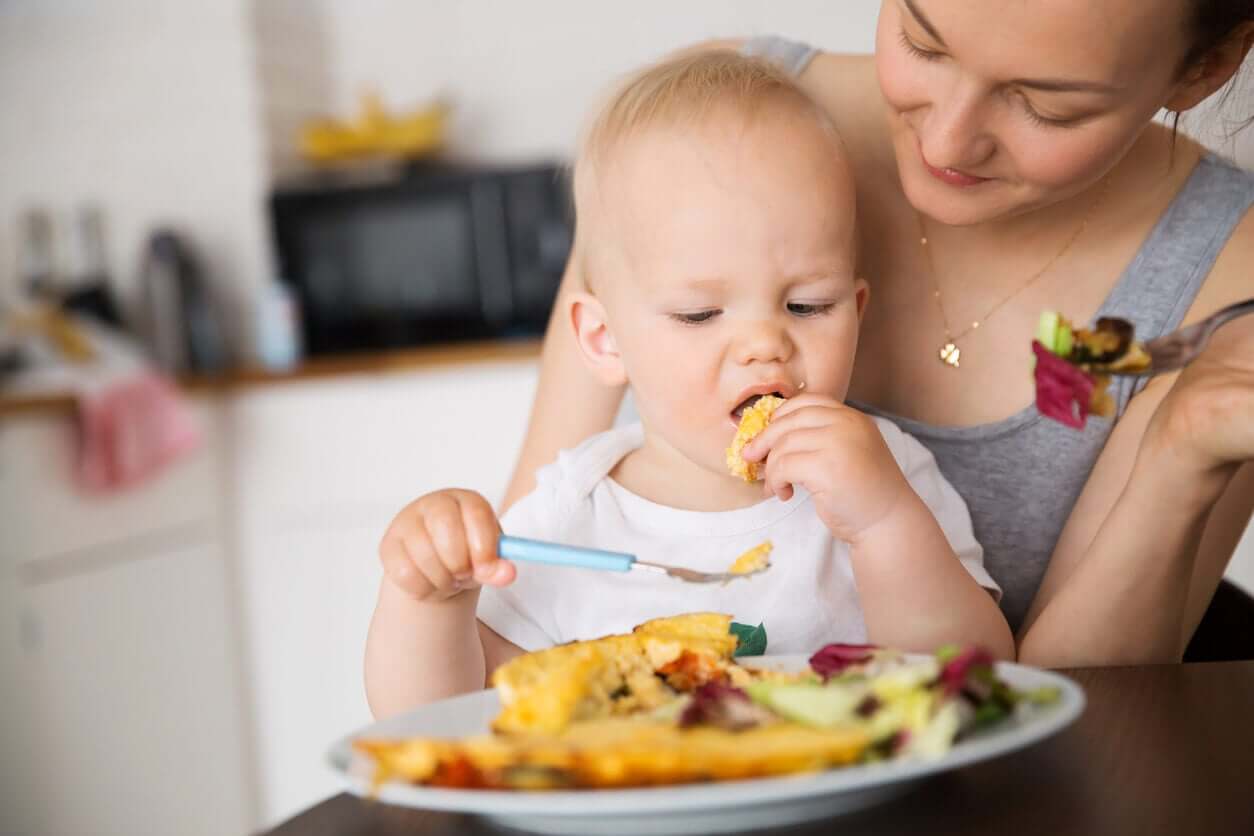How to Stimulate Chewing in Babies?

During the first year of life, children experience different changes in the way they eat. So, taking advantage of the incorporation of new foods to stimulate chewing in babies is the most advisable thing to do.
For some youngsters, this skill can become very difficult if it’s not practiced from the beginning. Therefore, learning the technique quickly and strengthening the structures involved are essential for smooth development.
In this article, we’ll tell you why it’s so important to encourage babies to chew and share some tips to motivate your little one.
The importance of chewing
Chewing is part of the digestive process and occurs after the choice and intake of food. After crushing the food through chewing, the food bolus is formed, which is swallowed in order to continue with digestion and excretion.
The teeth, the jaws, the temporomandibular joint, the tongue, the lips, the cheeks, and the palate participate in the oral processing of food. The chewing muscles are responsible for giving mobility to these structures and allow the jaw to open and close.
Starting to eat solid food is a milestone in children’s learning and adults play a fundamental role in it.
The appropriate time to introduce food is after 6 months of age and from there, infants can exercise chewing. The gradual incorporation of solid foods and different textures helps to strengthen all the structures responsible for this action.
It’s important that adults participate in the feeding of babies so that they observe them, imitate them, and feel the desire to eat what they see adults eating. In addition, supervision is essential to avoid any risk of an accident.
It’s worth clarifying that if babies’ teeth take time to come out, little ones are still capable of grinding food with their gums. Therefore, the lack of teeth isn’t a reason not to offer food. Little toothless babies can learn to chew just the same.

Why Stimulate Babies Chewing
Learning to chew from an early stage not only reduces the risk of choking, but also provides other benefits:
- Stimulating the correct development of the bones and muscles of the face.
- Favoring digestion: Chewing promotes the production of saliva, facilitates the absorption of nutrients, generates a greater feeling of satiety, and reduces reflux and gastritis.
- Protecting the oral cavity: The different textures of the food favor the self-cleaning of dental elements. This is because softer foods, such as purees or milk, adhere much more to the teeth and favor the development of cavities.
- Reduces anxiety, stress, and gum pain in babies, especially during the teething process.
How to stimulate chewing in babies
Learning to chew doesn’t happen overnight, as it’s a maturation process. Therefore, the incorporation of foods with different textures and flavors must be done gradually and with great patience. That way, the child not only manages a new experience but also puts it into practice and learns it.
Some experts suggest following a guided evolution in the supply of food according to its characteristics: First soft textures, then semi-solid, solid, and finally, hard textures. This progression allows the child to stimulate the different sensory receptors in the mouth, strengthen the muscles, and practice the movements that are necessary in order to chew.
When there’s some food that causes problems or rejection in the little one, you shouldn’t force the issue. It’s best to try again a few weeks later when the baby has a different predisposition or has acquired other skills for its management.
In the event that parents notice any problem regarding their child’s feeding or that they can’t adequately stimulate chewing, it’s best to see a pediatrician. There are certain functional, structural, or cultural alterations that can interfere with this learning. In fact, consultation with a speech therapist may sometimes be necessary.
Tips for Stimulating Babies Chewing
We’ve already mentioned the importance of offering foods with different textures and flavors from the early stages of life. But there are other practices that help stimulate chewing in babies as well:
- Give the child the same food that adults eat: Unless it’s a dangerous or very hard food, eating the same dishes encourages little ones to chew like the adults they observe.
- Eat with the child: Sitting at the table with the baby and eating at the same time favors the imitation of the action. Exaggerating chewing movements is also beneficial.
- Avoid distractions: The environment where they eat should be calm and without distractions. It’s an ideal moment to share with the family.
- Allow them to eat on their own: When the baby is able to choose the food they’ll pick up and feed themselves, it fosters their autonomy and their motivation to practice their new skills. Eating with their hands allows them to explore food, which also improves their motor skills and coordination.
- Restrict dangerous foods: Foods that are too hard, round, or small shouldn’t be offered, as they increase the risk of accidents.
- Be patient: Learning takes time and is achieved with perseverance and support. It shouldn’t be imposed, challenged, compared, or insisted on.
- Be respectful with the child: For this skill to be incorporated without any tension, it’s essential to respect the child’s timing and choices.

Accompany learning
Curiosity is the most important driving force behind learning and can be the biggest incentive for a baby’s chewing development. So, it’s important to let them explore and experiment freely.
A close, respectful, and loving accompaniment of this process is the best help that you can give your little one.
During the first year of life, children experience different changes in the way they eat. So, taking advantage of the incorporation of new foods to stimulate chewing in babies is the most advisable thing to do.
For some youngsters, this skill can become very difficult if it’s not practiced from the beginning. Therefore, learning the technique quickly and strengthening the structures involved are essential for smooth development.
In this article, we’ll tell you why it’s so important to encourage babies to chew and share some tips to motivate your little one.
The importance of chewing
Chewing is part of the digestive process and occurs after the choice and intake of food. After crushing the food through chewing, the food bolus is formed, which is swallowed in order to continue with digestion and excretion.
The teeth, the jaws, the temporomandibular joint, the tongue, the lips, the cheeks, and the palate participate in the oral processing of food. The chewing muscles are responsible for giving mobility to these structures and allow the jaw to open and close.
Starting to eat solid food is a milestone in children’s learning and adults play a fundamental role in it.
The appropriate time to introduce food is after 6 months of age and from there, infants can exercise chewing. The gradual incorporation of solid foods and different textures helps to strengthen all the structures responsible for this action.
It’s important that adults participate in the feeding of babies so that they observe them, imitate them, and feel the desire to eat what they see adults eating. In addition, supervision is essential to avoid any risk of an accident.
It’s worth clarifying that if babies’ teeth take time to come out, little ones are still capable of grinding food with their gums. Therefore, the lack of teeth isn’t a reason not to offer food. Little toothless babies can learn to chew just the same.

Why Stimulate Babies Chewing
Learning to chew from an early stage not only reduces the risk of choking, but also provides other benefits:
- Stimulating the correct development of the bones and muscles of the face.
- Favoring digestion: Chewing promotes the production of saliva, facilitates the absorption of nutrients, generates a greater feeling of satiety, and reduces reflux and gastritis.
- Protecting the oral cavity: The different textures of the food favor the self-cleaning of dental elements. This is because softer foods, such as purees or milk, adhere much more to the teeth and favor the development of cavities.
- Reduces anxiety, stress, and gum pain in babies, especially during the teething process.
How to stimulate chewing in babies
Learning to chew doesn’t happen overnight, as it’s a maturation process. Therefore, the incorporation of foods with different textures and flavors must be done gradually and with great patience. That way, the child not only manages a new experience but also puts it into practice and learns it.
Some experts suggest following a guided evolution in the supply of food according to its characteristics: First soft textures, then semi-solid, solid, and finally, hard textures. This progression allows the child to stimulate the different sensory receptors in the mouth, strengthen the muscles, and practice the movements that are necessary in order to chew.
When there’s some food that causes problems or rejection in the little one, you shouldn’t force the issue. It’s best to try again a few weeks later when the baby has a different predisposition or has acquired other skills for its management.
In the event that parents notice any problem regarding their child’s feeding or that they can’t adequately stimulate chewing, it’s best to see a pediatrician. There are certain functional, structural, or cultural alterations that can interfere with this learning. In fact, consultation with a speech therapist may sometimes be necessary.
Tips for Stimulating Babies Chewing
We’ve already mentioned the importance of offering foods with different textures and flavors from the early stages of life. But there are other practices that help stimulate chewing in babies as well:
- Give the child the same food that adults eat: Unless it’s a dangerous or very hard food, eating the same dishes encourages little ones to chew like the adults they observe.
- Eat with the child: Sitting at the table with the baby and eating at the same time favors the imitation of the action. Exaggerating chewing movements is also beneficial.
- Avoid distractions: The environment where they eat should be calm and without distractions. It’s an ideal moment to share with the family.
- Allow them to eat on their own: When the baby is able to choose the food they’ll pick up and feed themselves, it fosters their autonomy and their motivation to practice their new skills. Eating with their hands allows them to explore food, which also improves their motor skills and coordination.
- Restrict dangerous foods: Foods that are too hard, round, or small shouldn’t be offered, as they increase the risk of accidents.
- Be patient: Learning takes time and is achieved with perseverance and support. It shouldn’t be imposed, challenged, compared, or insisted on.
- Be respectful with the child: For this skill to be incorporated without any tension, it’s essential to respect the child’s timing and choices.

Accompany learning
Curiosity is the most important driving force behind learning and can be the biggest incentive for a baby’s chewing development. So, it’s important to let them explore and experiment freely.
A close, respectful, and loving accompaniment of this process is the best help that you can give your little one.
All cited sources were thoroughly reviewed by our team to ensure their quality, reliability, currency, and validity. The bibliography of this article was considered reliable and of academic or scientific accuracy.
- Pinto, J. M., Chávez, D. B., & Navarrete, C. (2018). Salud bucal en el primer año de vida. Revisión de la literatura y protocolo de atención odontológica al bebé.
- Zaragoza Molinés, L., & Tosat Mancho, C. Baby Led Weaning: Un enfoque de alimentación complementaria dirigida por el bebé. Revisión bibliográfica.
- DE, C. E. A. TEXTURAS EVOLUTIVAS EN LA INTRODUCCIÓN DE NUEVOS ALIMENTOS.
- Fuentes Pomares, R. (2020). Beneficios y riesgos que presenta la práctica del BLW como método de alimentación complementaria.
- Zúñiga, M. F. S., Holguín, C., Mamián, A. M., & Delgado-Noguera, M. (2017). Conocimientos maternos sobre alimentación complementaria en Latinoamérica: revisión narrativa. Revista de la Facultad de Ciencias de la Salud Universidad del Cauca, 19(2), 20-28.
- Enjuanes, B. P. Programa de Educación para la Salud: método “Baby-Led Weaning”.
- Jiménez Acosta, S. M., Martín González, I., Rodríguez Suárez, A., Silvera Téllez, D., Núñez Torres, E., & Alfonso Fagué, K. (2018). Prácticas de alimentación en niños de 6 a 23 meses de edad. Revista cubana de pediatría, 90(1), 79-93.
- Forero, Y., Acevedo, M. J., Hernández, J. A., & Morales, G. E. (2018). La alimentación complementaria: Una práctica entre dos saberes. Revista chilena de pediatría, 89(5), 612-620.
- Brown, A., Jones, S. W., & Rowan, H. (2017). Baby-led weaning: the evidence to date. Current nutrition reports, 6(2), 148-156.
- Rowan, H., Lee, M., & Brown, A. (2019). Differences in dietary composition between infants introduced to complementary foods using Baby‐led weaning and traditional spoon feeding. Journal of Human Nutrition and Dietetics, 32(1), 11-20.
This text is provided for informational purposes only and does not replace consultation with a professional. If in doubt, consult your specialist.








